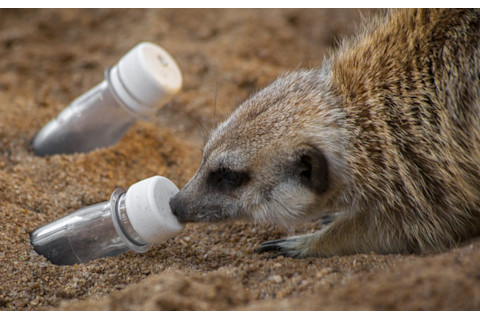
If your favorite activity is lying motionless on the ground, you'd better make sure hungry animals can't find you. Snakes and other creatures that hunt by ambush, waiting for their prey to wander past, often have impressive visual camouflage. But at least one type of viper seems to disguise itself in another way, too: its smell is undetectable to predators. Puff adders (Bitis arietans) are big, fat vipers that move around very little while they wait for prey. They're widespread in Africa. Despite carrying powerful venom, these sluggish snakes often become meals for other animals. Ashadee Kay Miller, a graduate student at the University of the Witwatersrand in Johannesburg, South Africa, decided to investigate the smelliness of puff adders because of some strange observations her coauthor Graham Alexander had made in the wild. Alexander spent a lot of time tracking these snakes in South Africa, and noticed that other animals were often oblivious to puff adders. He saw dogs and mongooses, with their noses to the ground and actively sniffing, walk right over the snakes. These animals would have been happy to eat a puff adder if they'd found it. Similarly, here's a porcupine waltzing over a puff adder that's lying in ambush: https://youtu.be/MfyN8ZzMLzo Miller wondered whether these snakes camouflage themselves not just in looks, but in smell. She and her coauthors began their study by training four dogs to detect snake scents. After sniffing a cloth that had touched a certain snake, the dogs would seek out a matching smell, then sit or lie down in front of it. In tests, a dog sniffed a sample, then was presented with a set of six lidless glass jars. One held a scent sample from the same snake it had just smelled. Two jars held totally clean controls. Three more held scent samples from the snake's environment—they might smell like the terrarium or vegetation, but not the snake itself. The researchers tested the dogs on five different species of "active foraging" snakes—animals that hunt by slithering around, rather than by staying in one place like the puff adder does. The dogs had little trouble picking out the scents of these snakes from the smell lineups. Their accuracy was better than 80 percent. But both wild and captive puff adders stumped the dogs. When the dogs tried to find matches for these scents, they may as well have been guessing. The researchers tried the experiment again, this time with captive meerkats. (Unlike dogs, which were rewarded with toys and food treats during their training, the meerkats got rewards of mealworms or cockroaches. Miller notes that the meerkats were remarkably easy to train. They learned the task in just two months, compared to three months for the dogs. And, Miller says, she often had a hard time convincing a meerkat to leave the scent-matching apparatus when its turn was over.) The meerkats sniffed tubes of scent and scratched when they found one that matched what a researcher had given them. Like the dogs, the meerkats could accurately match the smell of an active-foraging snake. But they couldn't tell the scent of the puff adder apart from the environmental scent samples. "The whole experiment surprised me, really," Miller says. All the earlier research she had read suggested that living, metabolizing animals have to be smelly. Their bodies give off odorous molecules as an unavoidable side effect of being alive. Yet the results of Miller's study seemed clear. Dogs and meerkats—both skilled sniffers that hunt their meals by scent—could sniff out other snakes but not the puff adder. It would make sense for these snakes to have evolved an odor disguise. Since their lifestyle makes them so vulnerable to predators, any change that made a snake slightly harder to detect would give it an advantage. The researchers speculate that snakes like the puff adder might have extra-slow metabolisms that release fewer smelly compounds into the air. Their body temperatures could also affect how easy they are to smell. The puff adder might not be unique. Maybe other snakes that hunt by ambushing their prey have also evolved undetectable scents, the scientists say. It would be a great evolutionary strategy—no matter how many porcupines stepped on your head.

Images and video courtesy of Ashadee Kay Miller.
Miller AK, Maritz B, McKay S, Glaudas X, & Alexander GJ (2015). An ambusher's arsenal: chemical crypsis in the puff adder (Bitis arietans). Proceedings. Biological sciences / The Royal Society, 282 (1821) PMID: 26674950













